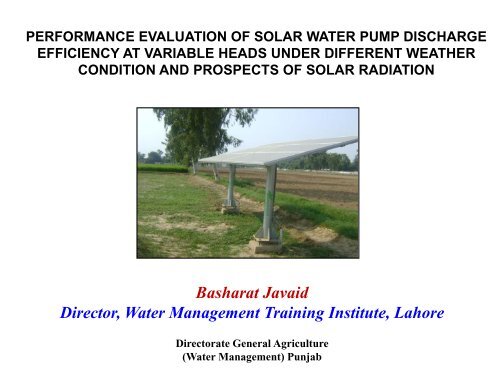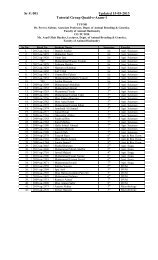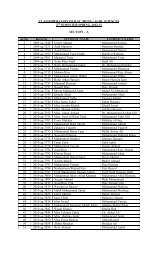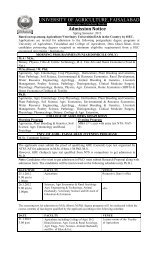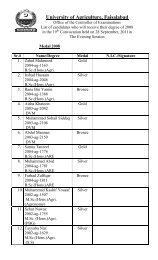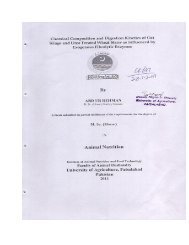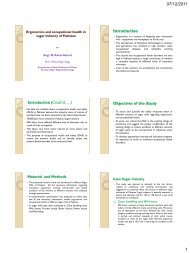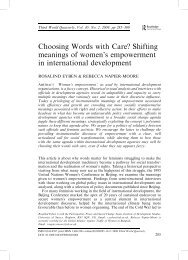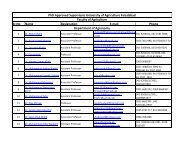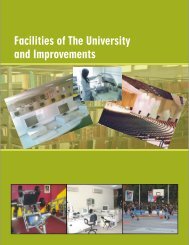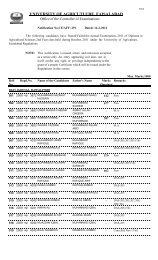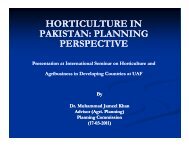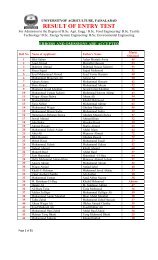performance evaluation of solar water pump
performance evaluation of solar water pump
performance evaluation of solar water pump
Create successful ePaper yourself
Turn your PDF publications into a flip-book with our unique Google optimized e-Paper software.
PERFORMANCE EVALUATION OF SOLAR WATER PUMP DISCHARGE<br />
EFFICIENCY AT VARIABLE HEADS UNDER DIFFERENT WEATHER<br />
CONDITION AND PROSPECTS OF SOLAR RADIATION<br />
Basharat Javaid<br />
Director, Water Management Training Institute, Lahore<br />
Directorate General Agriculture<br />
(Water Management) Punjab
INTRODUCTION<br />
‣ The sun is the natural source <strong>of</strong> energy for an independent <strong>water</strong><br />
supply. Solar <strong>pump</strong>s operate anywhere the sun shines, and the longer<br />
it shines, the more <strong>water</strong> they <strong>pump</strong>s<br />
‣ Agricultural production through irrigation with electric tubewells is hit<br />
badly by energy crises as the grid electricity in remote areas is<br />
extremely short<br />
‣ The use <strong>of</strong> renewable energy resources and replacement <strong>of</strong> existing<br />
non-renewable energy source <strong>of</strong> fossil fuels for irrigation tubewells<br />
with renewable energy such as <strong>solar</strong> or wind could be a viable option
PROSPECTS OF SOLAR ENERGY IN PAKISTAN<br />
• Solar energy is available for more than 300 days a year in Pakistan<br />
with about 6-8 hours effective daylight hours.<br />
• Most parts <strong>of</strong> the Pakistan receive very high <strong>solar</strong> radiation<br />
intensities about (5kwh/m 2 /day)<br />
• The arid/ semi-arid climate <strong>of</strong> the Punjab provides ideal conditions for<br />
adoption <strong>of</strong> <strong>solar</strong> energy for operating irrigation <strong>water</strong> <strong>pump</strong>s.<br />
• In the present scenario, when the electricity is insufficient for<br />
domestic use and fuel prices are increasing exponentially, <strong>solar</strong><br />
<strong>water</strong> <strong>pump</strong>s could be a viable solution for irrigation
PROSPECTS OF SOLAR ENERGY IN PAKISTAN
IMPORTANCE OF SOLAR WATER PUMPING<br />
• A natural match between the availability <strong>of</strong> sunlight and the need<br />
for <strong>water</strong>.<br />
• A reliable, efficient, sustainable and cost effective energy option<br />
for agriculture<br />
• It will create awareness among the farming community for<br />
conservation <strong>of</strong> resources and helped them to overcome<br />
hesitation in adoption <strong>of</strong> new interventions
JUSTIFICATION<br />
• More than one million tubewells in Pakistan including 750,000 diesel and<br />
70,000 electricity operated in the Punjab, consuming enormous fuel and<br />
energy<br />
• Government is heavily subsidizing electric tariff for agricultural<br />
tubewells putting additional burden on national exchequer<br />
• Agricultural production through irrigation with electric tubewells is hit<br />
badly by energy crises as the grid electricity in remote areas is<br />
extremely short<br />
• The replacement <strong>of</strong> existing non-renewable energy source <strong>of</strong> fossil fuels<br />
for irrigation tubewells with renewable energy resources such as <strong>solar</strong><br />
or wind is a viable option
SOLAR TECHNOLOGY<br />
• When light falls on the active surface, the electrons in a<br />
<strong>solar</strong> cell become energized and Photovoltaic array<br />
converts <strong>solar</strong> energy directly into electricity as DC<br />
• The power from a <strong>solar</strong> system and the volume <strong>of</strong> <strong>water</strong><br />
<strong>pump</strong>ed varies with the amount <strong>of</strong> <strong>solar</strong> radiation<br />
• The <strong>pump</strong> will have its own optimum discharge<br />
depending on the type and size <strong>of</strong> panel/ motor
COMPONENTS OF SOLAR WATER PUMP<br />
Photovoltaic <strong>pump</strong>s are consist up <strong>of</strong> three main<br />
components<br />
Power Source<br />
Photovoltaic <strong>solar</strong> module<br />
Motor (AC/ DC) & Pump<br />
Submersible<br />
Centrifugal<br />
Power Controllers<br />
Inverter<br />
Maximum Power Point Tracker
POWER SOURCE (PHOTOVOLTAIC MODULE)
SUBMERSIBLE PUMP
INVERTOR
METHODOLOGY<br />
• When the Photovoltaic (PV) module (array) is exposed to<br />
sunlight and light falls on the active surface, the electrons in<br />
a <strong>solar</strong> cell become energized and Photovoltaic array<br />
converts <strong>solar</strong> energy directly into electricity as Direct<br />
Current DC<br />
• The Photovoltaic PV module can also be used for AC<br />
applications using an inverter. Photovoltaic PV is especially<br />
suitable for <strong>water</strong> <strong>pump</strong>ing because energy need not be<br />
stored for night <strong>pump</strong>ing. Instead, <strong>water</strong> can be stored to<br />
supply <strong>water</strong> at night<br />
• The power from a <strong>solar</strong> system and the volume <strong>of</strong> <strong>water</strong><br />
<strong>pump</strong>ed varies with the amount <strong>of</strong> <strong>solar</strong> radiation
WORKING OF SOLAR WATER PUMP<br />
The system mainly consists <strong>of</strong> PV<br />
array, inverter, controller, submersible <strong>pump</strong> and <strong>water</strong> tank.<br />
• A photovoltaic array is use to collect <strong>solar</strong> radiation and converts<br />
directly into electricity as DC and then into AC through Inverter<br />
• The <strong>pump</strong> will have an electric motor to drive it and use to transfer <strong>of</strong><br />
fluid<br />
• An appropriate <strong>water</strong> tank to store <strong>water</strong> for later use.<br />
• Stands for the PV array has the tracking function (by manual<br />
regulating the stands), significantly increasing the working time <strong>of</strong> the<br />
system to <strong>pump</strong> more <strong>water</strong>.
SOLAR WATER PUMP
INSTALLATION OF SOLAR WATER PUMP
BORING FOR SOLAR WATER PUMP
FOUNDATION FOR STANDS
INSTALLATION OF PANEL
PILOT TESTING OF SOLAR WATER<br />
PUMPS
PROJECT DIGEST<br />
<br />
<br />
<br />
Name <strong>of</strong> the Project<br />
• PILOT TESTING OF SOLAR WATER PUMPS<br />
Location<br />
• The project will be implemented through out the Punjab province by<br />
installing nine (9) Solar Water Pumps at selected government farms.<br />
Sponsoring<br />
• Government <strong>of</strong> the Punjab through Agriculture Department<br />
<br />
Execution<br />
• The Punjab Agriculture Department through Directorate General<br />
Agriculture (Water Management) Punjab, Lahore<br />
<br />
<br />
o Supply & Services Companies<br />
Project Period<br />
• 2009-10 to 2011-12<br />
Project Cost<br />
• 19.22 million
PROJECT OBJECTIVES<br />
<br />
The main objectives <strong>of</strong> the project include, interalia, the<br />
followings<br />
• Assess the effects <strong>of</strong> <strong>solar</strong> radiation (insolation) on <strong>solar</strong> array<br />
outputs and subsequent variations in <strong>pump</strong>age at various<br />
locations around the province.<br />
• Evaluate the <strong>performance</strong> <strong>of</strong> different types <strong>of</strong> <strong>solar</strong> energy<br />
arrays (fixed & moving) over extended periods <strong>of</strong> time under<br />
different agro-climatic conditions as the rated specifications<br />
given by manufacturers generally reflect peak <strong>performance</strong>s<br />
under ideal conditions and do not accurately indicate long term<br />
<strong>performance</strong> under less than ideal or poor conditions.<br />
• Compare manufacturer’s specifications under less than ideal or<br />
poor conditions.
PROJECT OBJECTIVES<br />
• Compare manufacturer’s specifications under less than ideal or poor<br />
conditions.<br />
• Find out pros and cons <strong>of</strong> using fixed array systems having lower cost and<br />
better stability but lower efficiency, versus <strong>solar</strong> tracking arrays which<br />
have higher efficiencies but are more expensive and difficult to maintain.<br />
• Integration <strong>of</strong> <strong>solar</strong> energy <strong>pump</strong>ing units with different high efficiency<br />
irrigation systems such as drip, trickle, gated pipes etc.<br />
• Determine the most optimum configuration, in terms <strong>of</strong><br />
efficiency, economic viability and reliability.<br />
• Develop most optimum cropping patterns (year round) which <strong>of</strong>fer<br />
maximum returns to investments in <strong>solar</strong> energy <strong>pump</strong>ing systems.
PROJECT COMPONENTS<br />
The main components envisaged for proposed scheme<br />
include, interalia, the followings.<br />
• Installation <strong>of</strong> 9 Solar Water Pumps at selected government farms in<br />
the province<br />
• Construction <strong>of</strong> <strong>water</strong> storage tank<br />
• Data collection <strong>of</strong> each site and its compilation<br />
• Training / Capacity building <strong>of</strong> the operator (Field Assistant) in<br />
operation, maintenance, and management <strong>of</strong> <strong>solar</strong> <strong>water</strong> <strong>pump</strong>s<br />
Contd…
Advantages<br />
• No fuel requirement for operation<br />
• A little maintenance<br />
• Environmentally benign<br />
• Long panel life (15-20 years)<br />
Limitations<br />
• High initial capital cost<br />
• Uses unfamiliar technology<br />
o DC motors<br />
o Submersible <strong>pump</strong>s<br />
o Alternator/ batteries for operating AC motors<br />
• Difficulty for arranging repair / spare parts<br />
• Susceptible to theft and vandalism
SELECTION CRITERIA<br />
The government farm<br />
following criteria<br />
were selected primarily on basis <strong>of</strong><br />
• Water <strong>of</strong> the farm is fit for irrigation<br />
• Provide 4 acres cultivated (preferably fertile, not barren/virgin) piece<br />
<strong>of</strong> land free <strong>of</strong> cost for project activities<br />
• Preferably shallow <strong>water</strong>table<br />
• Preference will be given to the farm where high efficiency irrigation<br />
system has already been installed<br />
Contd…
BASIC INFORMATION OF SITE AT SHEIKHUPURA<br />
Sr.<br />
No<br />
Particular<br />
1 GPS Coordinates<br />
Description<br />
N 31 42.541’<br />
E 73 57.971’<br />
2 Water table Depth (Meters) 20<br />
3 Water Quality Good<br />
4 Existing Crops<br />
Vegetables & Crops (Tomato,<br />
Wheat, Rice)<br />
5 Crop to be Grown (Wheat, Vegetables )<br />
6 Current Irrigation Method Conventional (Furrow Irrigation)<br />
7 Proposed Irrigation Method Furrow & Flood Irrigation<br />
8 Soil Type Clay loam
EFFECT OF GROUND WATER TABLE (H) ON DISCHARGE<br />
AT CONSTANT POWER<br />
Head<br />
Power<br />
2KW 3KW 4KW<br />
H1 (25 ft) 14 17 22.667<br />
H2 (45 ft) 10 14 17.667<br />
H3 (65 ft) 7.333 9.667 14<br />
Discharge in LPS
Discharge and Head
Relationship <strong>of</strong> Discharge with Duration
Relationship <strong>of</strong> Discharge with Duration
Discharge Difference among different districts
SUMMARY<br />
• The increasing fuel prices day by day and depletion <strong>of</strong> fossil fuel<br />
reserves is making a question mark on the reliability <strong>of</strong> diesel<br />
operated <strong>water</strong> <strong>pump</strong>ing systems.<br />
• The shortfall <strong>of</strong> electricity in Pakistan and the decreasing capacity <strong>of</strong><br />
current <strong>water</strong> storage reservoirs is also an alarming sign which forces<br />
the farmers to look for alternatives <strong>of</strong> the conventional <strong>water</strong> <strong>pump</strong>ing<br />
options.<br />
• The sun shine hours are abundant enough throughout the year in<br />
Pakistan; therefore, <strong>solar</strong> <strong>water</strong> <strong>pump</strong>ing is a reliable option for remote<br />
areas.<br />
• The 1.8 KW <strong>solar</strong> <strong>water</strong> <strong>pump</strong>ing system is adequate for generating an<br />
optimum flow rate for 3-4 acre and will be more effective if use with<br />
drip irrigation
Thanks


